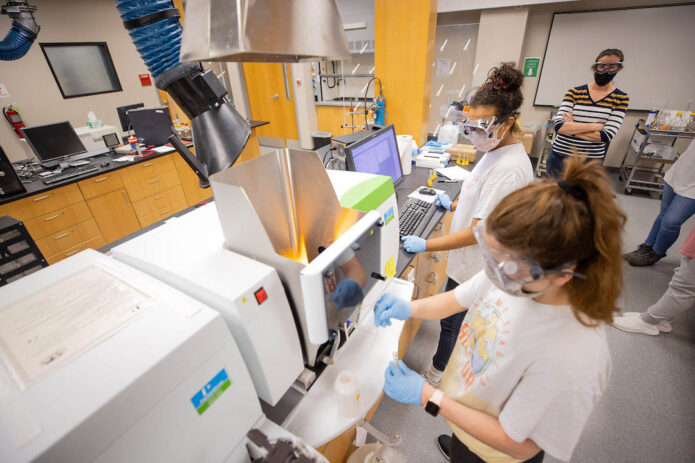 Clarksville, TN – On a cloudless day 20 September ago, spectators shielded their eyes from the sun as Austin Peay State University (APSU) President Sherry Hoppe and Vice President Bruce Speck unveiled a plaque commemorating the opening of the Sundquist Science Complex.
Clarksville, TN – On a cloudless day 20 September ago, spectators shielded their eyes from the sun as Austin Peay State University (APSU) President Sherry Hoppe and Vice President Bruce Speck unveiled a plaque commemorating the opening of the Sundquist Science Complex.
“I would say we have the best undergraduate science teaching facility in the region,” said Dr. Lisa Sullivan, chair of the APSU Department of Chemistry. “When we give people a tour, they’re always impressed with the facility.”
When Sundquist opened 20 years ago, faculty and students moved from cramped offices and classrooms that lacked appropriate research space. The new building offered them discipline-focused research spaces along with a planetarium, herbarium, and greenhouse.
“Just the chemistry department has three times the space that it had in McCord,” said Sullivan, who attended Austin Peay State University as an undergraduate student in the 1990s before attending graduate school at Vanderbilt University. “We really didn’t have research space in McCord, maybe a closet. Now, we have individual research space that is set apart from our teaching space.”
Biology lab in a kitchen classroom

The dedicated spaces in the Sundquist complex changed the game for Austin Peay students and professors.
Dr. Cindy Taylor, a professor in the Department of Biology, started at Austin Peay State University, teaching in the three-story McCord building from 1992 to 2001.
“The bottom floor was basically physics, and we had some biology offices down there and a little bitty conference room,” she recalled. “The second floor was chemistry primarily, but there was a big lecture room, our biggest lecture room at the time. The third floor was primarily biology, and we did lecture and lab in the same room.
“The faculty’s office was typically in the back of the classroom,” Taylor added. “That building … we offered home economics for training teachers, and the lab we used was also the kitchen for home economics class. They had kitchen sinks, and the students had to put their microscopes around the counter.”
Sullivan recalled as a student smelling the labs in McCord.
“Whenever you opened the doors at McCord, if there was an organic chemistry lab going on, you could immediately smell it,” she said. “That doesn’t happen at Sundquist.”
‘A whole new ballgame’

When Sundquist opened, the building elevated Austin Peay State University’s teaching spaces past those at Vanderbilt, Sullivan said.
“When I walked into Sundquist, the facility was as good as we had at Vanderbilt,” she said. “Austin Peay actually had a better teaching facility, and the research facility at the time at Vanderbilt was equivalent.”
The top-of-the-line teaching and research spaces had an immediate impact on Austin Peay.
“It’s a whole new ball game,” Sullivan said. “With the facilities we have in this building, we are able to hire faculty that have much greater research outreach and capabilities than we could have ever hired if we’d stayed in McCord.”



